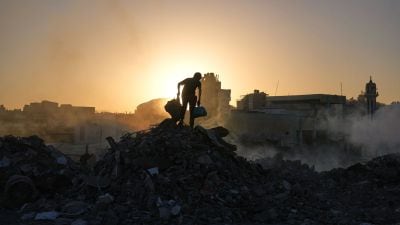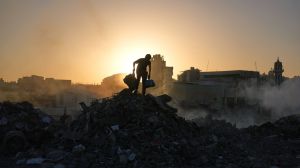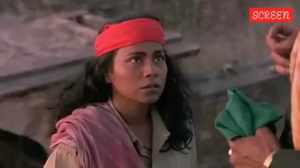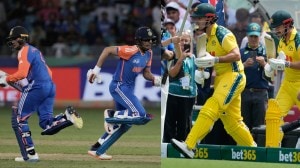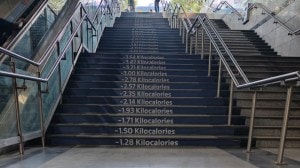‘My husband was pinned to ground and shot dead ’: Chameli Devi’s 44-year wait for justice ends
In 1981, 17 dacoits shot dead 24 Dalits in Uttar Pradesh’s Dehauli village. Over four decades later, three of the accused were awarded capital punishment by a local court.
 A special dacoity court in Mainpuri sentenced Ram Sevak, Kaptan Singh and Rampal, all in their 60s, to death on March 18 this year. (Photo - Special Arrangement)
A special dacoity court in Mainpuri sentenced Ram Sevak, Kaptan Singh and Rampal, all in their 60s, to death on March 18 this year. (Photo - Special Arrangement)A wizened Chameli Devi recalls how thirst forced her to drink from the drain she ended up lying next to all night with a broken leg on November 18, 1981. Hours earlier, around 4.30 pm, her potato farmer husband was pinned to the ground — “a foot on his chest” — in his field by one of the 17 dacoits who had entered Uttar Pradesh’s Dehauli village and shot dead.
Twenty-three others belonging to Chameli’s extended family in the village, including seven women and two minors, were shot dead after her husband.
On March 18 this year, nearly 44 years later, a special dacoity court in Mainpuri sentenced Ram Sevak, Kaptan Singh and Rampal, all in their 60s, to death. “There were 17 accused in the case. Of these, 13 have died and one is still absconding,” says prosecutor Rohit Sharma, adding that all charge-sheeted witnesses died during the pendency of the trial.
 Prime Minister Indira Gandhi with survivors of the tragedy during her visit to the Dehuli village in Uttar Pradesh on November 27, 1981. (Express Archive)
Prime Minister Indira Gandhi with survivors of the tragedy during her visit to the Dehuli village in Uttar Pradesh on November 27, 1981. (Express Archive)
Defence counsel Hirday Chaturvedi, who has been handling the case since it was transferred to Mainpuri in 2024 on the orders of the Allahabad High Court, says, “The first hearing that took place in Mainpuri was also the final hearing. The case relied on just five witnesses. We will file an appeal in the High Court.”
Nearly 60 km from the shimmering bangles sold in the bylanes of Firozabad lies Dehauli, a quiet and sparsely populated village. A paved road lined with small shops and modest pucca houses leads one into the village. A few kilometres on, the path crumbles and grows increasingly narrow, even as sturdy buildings give way to small fields, where a new yield of potato is awaiting harvest.
Sacks of freshly unearthed tubers, destined for months of storage in rented kunds (cold storage), are scattered across fields. Bent at the waist, the farmers use shovels to collect the last of their yield, before sowing maize, groundnuts and black gram in place of potatoes.
Sitting on the mud floor of her brick house in Dehauli village, Chameli says, “The dacoits were dressed in khaki clothes on that day. My son was around seven years old at the time of the incident. We barely survived the carnage.”
Wearing a floral saree in shades of blue, she recalls, “I was hiding in the house with my son when they (the dacoits) broke open the door. I took my son and ran up the roof. To escape the dacoits, I jumped from house to house, till I fell down next to a drain. The fall broke my leg… We were rescued the next morning.”
 Survivor Chameli Devi with her son at their residence in Dehuli village. Her husband was shot dead by the dacoits on November 18, 1981. (Photo – Saman Husain)
Survivor Chameli Devi with her son at their residence in Dehuli village. Her husband was shot dead by the dacoits on November 18, 1981. (Photo – Saman Husain)
According to the prosecution, the mass murder took place after four Dalit residents of the village testified in court against the Radhey-Santosh gang, whose members were mostly from the upper caste. The November 18, 1981, murders, the prosecution told the court, were intended to “intimidate” the villagers.
Prosecutor Sharma says, “A year before the incident, a clash in the Radhey-Santosh gang had resulted in the arrest of two gang members. The village residents, who belonged to the Jatav community, were witnesses in that. This resulted in enmity between the two communities and the revenge firing in November 1981.”
Stating that a forensic team was called from Delhi to the village back then to recreate the crime scene, Sharma adds, “It took the authorities three days to complete the post-mortem due to the number of bodies.”
The incident was the second such case to be reported from the state that year. On February 14, 1981, 20 men, mostly from the Rajput community, were shot dead in Behmai village in Uttar Pradesh’s Kanpur Dehat district, by men said to belong to Phoolan Devi’s gang. The incident was allegedly a fallout of the murder of dacoit Vikram Mallah and Phoolan’s sexual assault.
A lot has changed for Dehauli village since November 1981. A part of Mainpuri district then, the village became a part of the newly created Firozabad district in 1989. Before the trial was moved to a local court in 2024, it dragged on for over two decades in the High Court.
What has not changed for its survivors is the pain of losing their loved ones. Though she was just eight years old in 1981, Nirmala Devi claims she has “near perfect recall” of the moment she lost her family. “My brother was shot in front of me. Twice. He succumbed to his injuries later. They killed my mother too,” says Nirmala, Chameli’s niece.
Sitting on a khat (cot) at his provision shop-cum-residence, Bhoop Singh, who lost eight members of his family that day, shudders at the mere mention of the date. A prime witness in the case, Bhoop Singh, says, “My sons, brothers, nephews, sisters… They were all killed that day. I saw it with my own eyes.”
Recalling how he survived the shooting, Bhoop Singh, sporting thick, snow white whiskers, recalls, “The Thakurs (the dacoits) started firing indiscriminately. I was in the village when I spotted the gang. I ran away… Men who were harvesting paddy that day lived. The ones who came face to face with the gang did not.”
Survivor Gitam Singh was just 10-year-old when he lost his elder brother on November 18, 1981. “Kuch yaadein hain, aur kuch bade-buzurgon se suna hai (I have some memories, while the rest are tales that I heard from my elders),” he says.
As the trial dragged on in the High Court for over 20 years, time took its toll on Gitam, who travelled over 400 km to Allahabad for years to testify. As he grew older and weaker, at his request, the case was transferred to a special court in Mainpuri in 2024.
 Bhoop Singh, the primary witness in the case, at his shop-cum-house in Dehuli village. He lost eight members of his family that day. (Photo – Saman Husain)
Bhoop Singh, the primary witness in the case, at his shop-cum-house in Dehuli village. He lost eight members of his family that day. (Photo – Saman Husain)
“Aadhe gawah bhi expire ho gaye, aur jin logon ne yeh qatl kiya tha, woh bhi mar gaye. Kuch log gaon chod ke chale gaye (half the witnesses are dead now, as are half the accused. Over the years, some people left the village),” he says.
Locals say many family lines, including those of the convicts, have ended over the years. Chaturvedi, the court-appointed lawyer for convict Ram Sevak, says, “His family is entirely gone. The two other convicts have just one or two surviving relatives.”
Though The Indian Express reached out to convict Kaptan Singh’s son at the village, he did not answer the door.
Meanwhile, Gitam recalled VIP visits to the village after the incident — from then Prime Minister Indira Gandhi and Uttar Pradesh Chief Minister V P Singh to BJP leader Atal Bihari Vajpayee.
According to a news report published in The Indian Express on November 29, 1981, Mrs Gandhi, who arrived in the “terrified” village in a helicopter on November 27, 1981, was accompanied by Union Industry Minister N D Tiwari, her MP son Rajiv Gandhi and CM Singh.
Describing the visit, the report states, “Mrs Gandhi squatted with the distraught Jatav women on the ground or stood in the midst of their menfolk, sharing their grief… She went from hut to hut, hearing from the women and other inmates accounts of the gruesome incident and offered them sympathy and promise of ‘all measures for their safety and welfare’.”
Locals say the Prime Minister granted the surviving families gun licenses and rifles for self-defense. Besides this, the government also provided jobs and allotted small government-run shops to 10 families.
With time however, the condition of these rifles has deteriorated — as has hope for “any real justice” among the survivors. Wearing a grim expression, Gitam says, “The accused have finally been given a death sentence, but no one knows what will happen next.”



- 01
- 02
- 03
- 04
- 05


